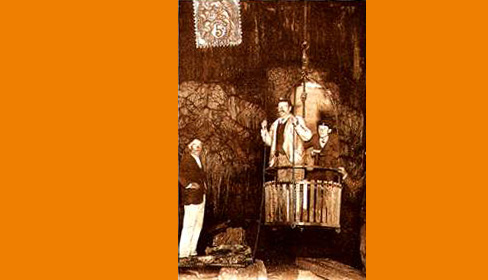With this legendary yet deep-seated reputation, the Trou de Promeissat (Promeissat Hole), "out of which trustworthy people who are still alive (1802), have seen flames shoot out several times", hardly fuelled the interest of explorers. However, towards 1755 a bold inhabitant of this region had enough nerve to want to brave the cave and probe the abyss.
"He was lowered into the cave in a basket attached with ropes, having taken the precaution of placing a bell, to which he held the cord, at the entrance; but after reaching a mediocre depth, he had himself pulled back up, and reported seeing large cavities that gave off a stifling vapour that prevented him from going down any further".
The site also had another more macabre reputation: that of being an easy place to dispose of the bodies of travellers who had been robbed and murdered in the surrounding area: the hole was ideally situated, next to what was at the time the major road between Sarlat and Bergerac, and used by stage-coaches. On Wednesday 29 April 1778, François de Paule Latapie, a factory inspector wrote in his "journal of rounds":
 "A half-league from Le Bugue, in the south-east, on a raised mound there is a hole, which is famous throughout the land due to the number of people who have perished there, some by accident, the others deliberately. It is known as the Trou de Proumeyssac (Proumeyssac Hole).
"A half-league from Le Bugue, in the south-east, on a raised mound there is a hole, which is famous throughout the land due to the number of people who have perished there, some by accident, the others deliberately. It is known as the Trou de Proumeyssac (Proumeyssac Hole).
Its entrance is like an oval shape that widens at the edges and has an approximate diameter of eight feet at its longest length. It widens as it gets deeper, and in such a way that it seems that the bottom is a vast cavern that connects with perhaps highly expanse lateral caves from right to left. By throwing the flaming straw which finished burning at the bottom, and on several occasions, I more or less saw the bottom of this hole, but it is covered with stones that have been thrown in. By listening closely at the edge of the hole, one can more or less hear the murmuring of the stream that in all likelihood flows west into the Dordogne river. The large stones which Mr Pélissier and I threw in took five beats of the artery before hitting the rock, which I estimate at four seconds: therefore the depth is probably a bit less than two hundred feet. The sound of the stone on these rocks echoes in the side caves. This hole, as I mentioned, is famous in this area because of the number of people who have died there.
The most well-known victim is a lord of Limeuil from the last century, who was thrown in by some of his vassals who had grown weary of his brutality.
he neighbours express their desire to have the hole filled up; but involuntary accidents could at least be avoided by covering the entrance with boards or masonry-work supported by small joists".
To prevent further misfortune, vain attempts were made to fill the hole, a genuine bottomless pit, in which cartloads upon cartloads of stones were thrown in for several days without any noticeable results.
he local population then decided to block the opening with an initial vault supported by tree trunks and piled-up soil. It didn't hold, and neither did a second one which was probably poorly propped up. It was then that Jean-Baptiste-Louis Pélissier de Barry, the royal judge of Le Bugue, whose son, a young man and lawyer like his father, had guided F. de Paule Latapie's tour in 1778, intervened. Having turned the dangerous narrow path that ran alongside the Cingle into a more convenient and appropriate path for the growing traffic, Mr de Barry continuing his charity, put an end to the terror inspired by this "solfatara", by covering its crater with solidly built superimposed vaults.
It should be noted that to complete this difficult work Mr de Barry came up with the idea of providing board and lodging to all the beggars living in the region in exchange for their services. This was, in reality, a preview of the paid community work to which we were recently introduced!
However, despite everyone's efforts, nature quickly reclaimed its rights, eliminating all traces. Only a worm-eaten cross indicated the proximity of the cave and the tragedies that had occurred there.


 "A half-league from Le Bugue, in the south-east, on a raised mound there is a hole, which is famous throughout the land due to the number of people who have perished there, some by accident, the others deliberately. It is known as the Trou de Proumeyssac (Proumeyssac Hole).
"A half-league from Le Bugue, in the south-east, on a raised mound there is a hole, which is famous throughout the land due to the number of people who have perished there, some by accident, the others deliberately. It is known as the Trou de Proumeyssac (Proumeyssac Hole).